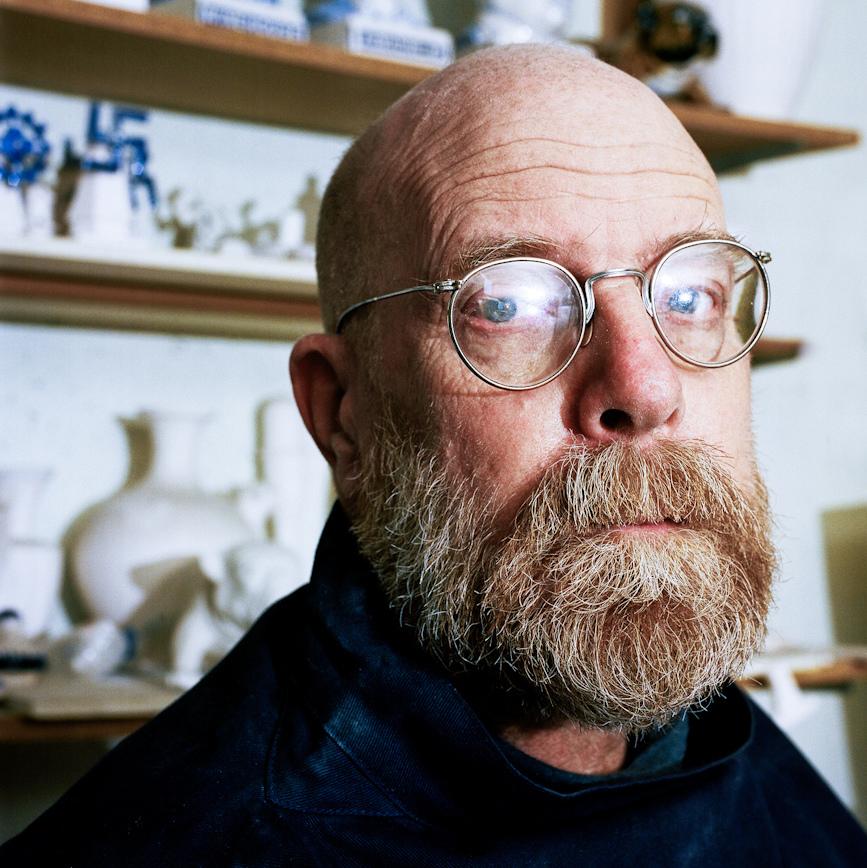Renowned Holocaust denying artist addresses provocative art, beliefs
Charles Krafft says he doesn’t believe the Holocaust could have happened. (Photo courtesy of KJPhotos.com.)
Seattle-based artist Charles Krafft is a painter and sculptor whose work is both provocative and respected — it’s been collected by major museums and prominently reviewed.
Krafft has received grants from the National Endowment for the Arts and the Soros Foundation. But some of his work consisted of imagery of dictators, notably Hitler, and swastikas in various contexts.
That imagery was used ironically, the artist said, and he was praised for it in the art world and the media. But earlier this year, a reporter for the Seattle Stranger discovered that Charles Krafft was not just an ironic provocateur.
Her article revealed that during the last decade, he had also become a Holocaust denier. Admirers of Krafft’s art were left wondering whether the use of swastikas and Hitler was a form of surreptitious propaganda for hate.
Krafft maintains that what was intended as ironic then remains ironic now.
“I knew that these were hot symbols,” he said. “I’d been working with this group, Neue Slowenische Kunst, a Slovenian collective, and they were mixing tropes that included Nazi symbols. That’s kind of where I got infected with this idea, where I began to think about using them myself.
“Prior to that, I was apolitical. I was using these symbols before I was a Holocaust denier. I wasn’t even interested in the Holocaust, really,” he said.
Krafft asserts that he is not a racist or a Nazi, but a “revisionist” whose ideas are based in history.
“I just don’t buy this thing about 2,000 people a day being gassed at Auschwitz,” Krafft said. “It doesn’t add up to me technologically.”
It is widely and generally accepted that some 10 to 11 million people, mostly Jews but also Soviets, handicapped people and prisoners of wars, were killed by Hitler’s Nazi Germany.
But Krafft stands by his work, including a particularly controversial teapot, in the shape of Hitler’s head.
“I think he’s been demonized excessively,” Krafft said. “I’m not trying to resurrect National Socialism or Hitlerism, but my opinion of the man has changed considerably since I began my revisionist investigations. So the teapot started out ironical and still stays ironical. Because for God’s sake, if you look at that thing, it’s goofy. And I don’t understand why people now think that this is some sort of an attempt to slip my evil neo-Nazi ideology into the homes, museums, and galleries of the unsuspecting.”
Krafft’s public embrace of Holocaust denial is likely to wreck his career as a respected artist — his works were recently withdrawn from an exhibition in France — though he may garner fans among extremists.
“The thing about being a Holocaust denier — when they throw that word around at you, it’s not good socially, so I’m having a little bit of a tough time dealing with old friends that are suddenly distancing themselves from me,” Krafft said. “But I don’t have any regrets for making the art that I did or for my intellectual curiosity, which led me to this opinion that I have, that I’m holding right now. And I’m saying it’s not forever. I mean, I could change my mind about it.”
Krafft doesn’t believe this change of belief has anything to do with mental illness — just an informed change of belief.
“Nobody’s said I’m crazy, although somebody wrote that I might be getting senile. Do you think I need some sort of psychiatric help?” Krafft asked. “If I find a psychiatrist that can help me … I’ll get back to you and let you know when I’m well.”
Every day, reporters and producers at The World are hard at work bringing you human-centered news from across the globe. But we can’t do it without you. We need your support to ensure we can continue this work for another year.
Make a gift today, and you’ll help us unlock a matching gift of $67,000!
